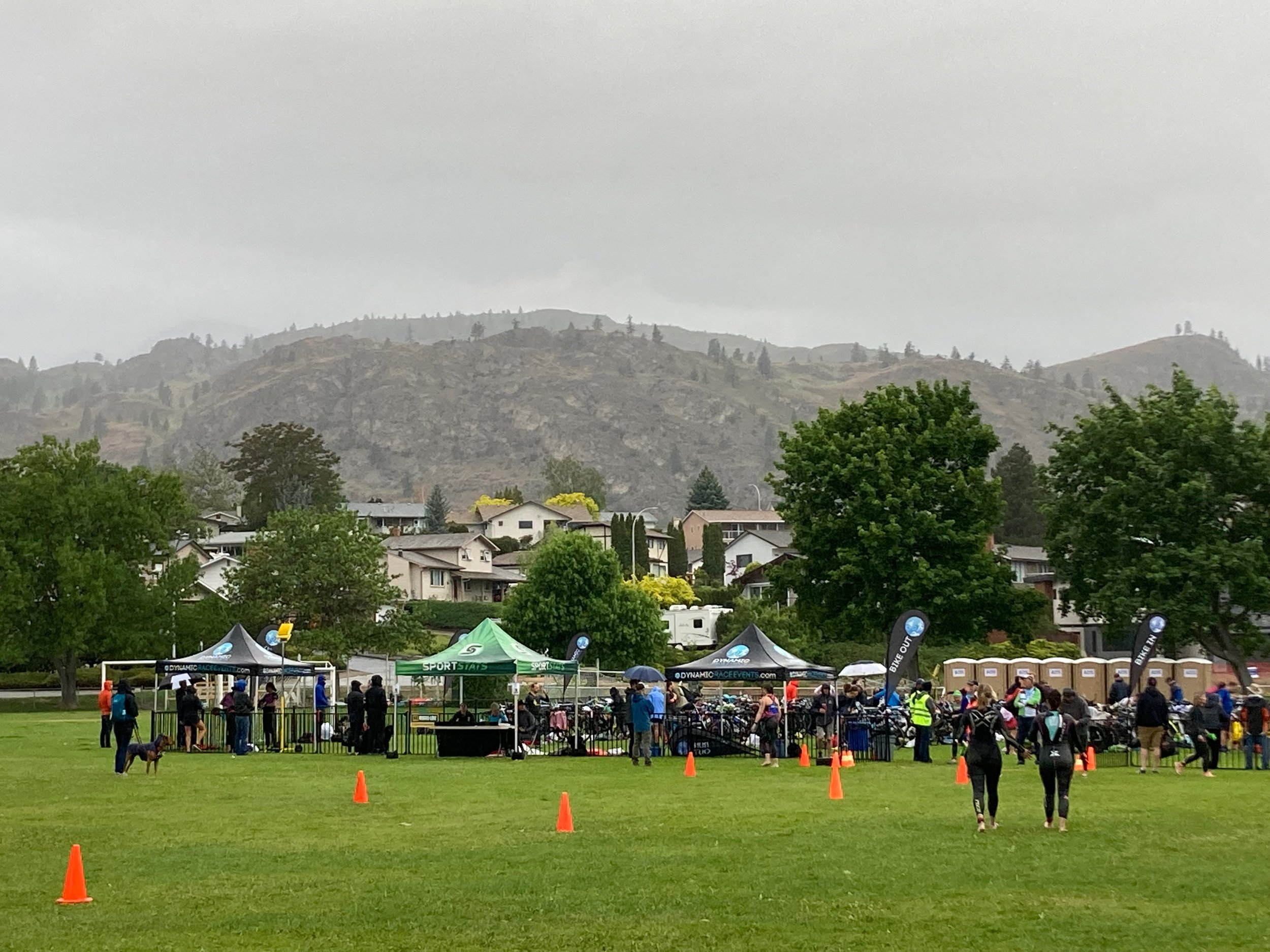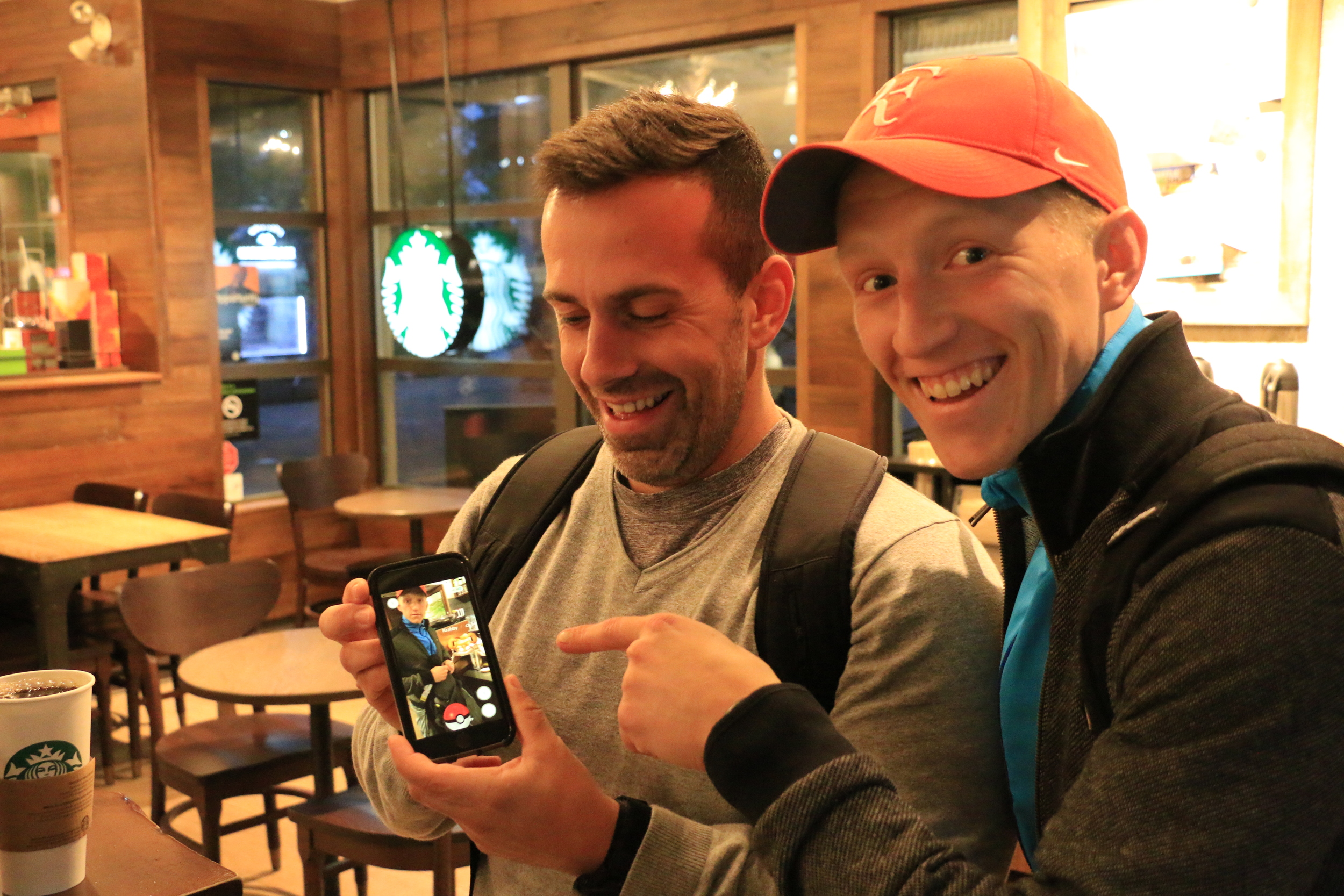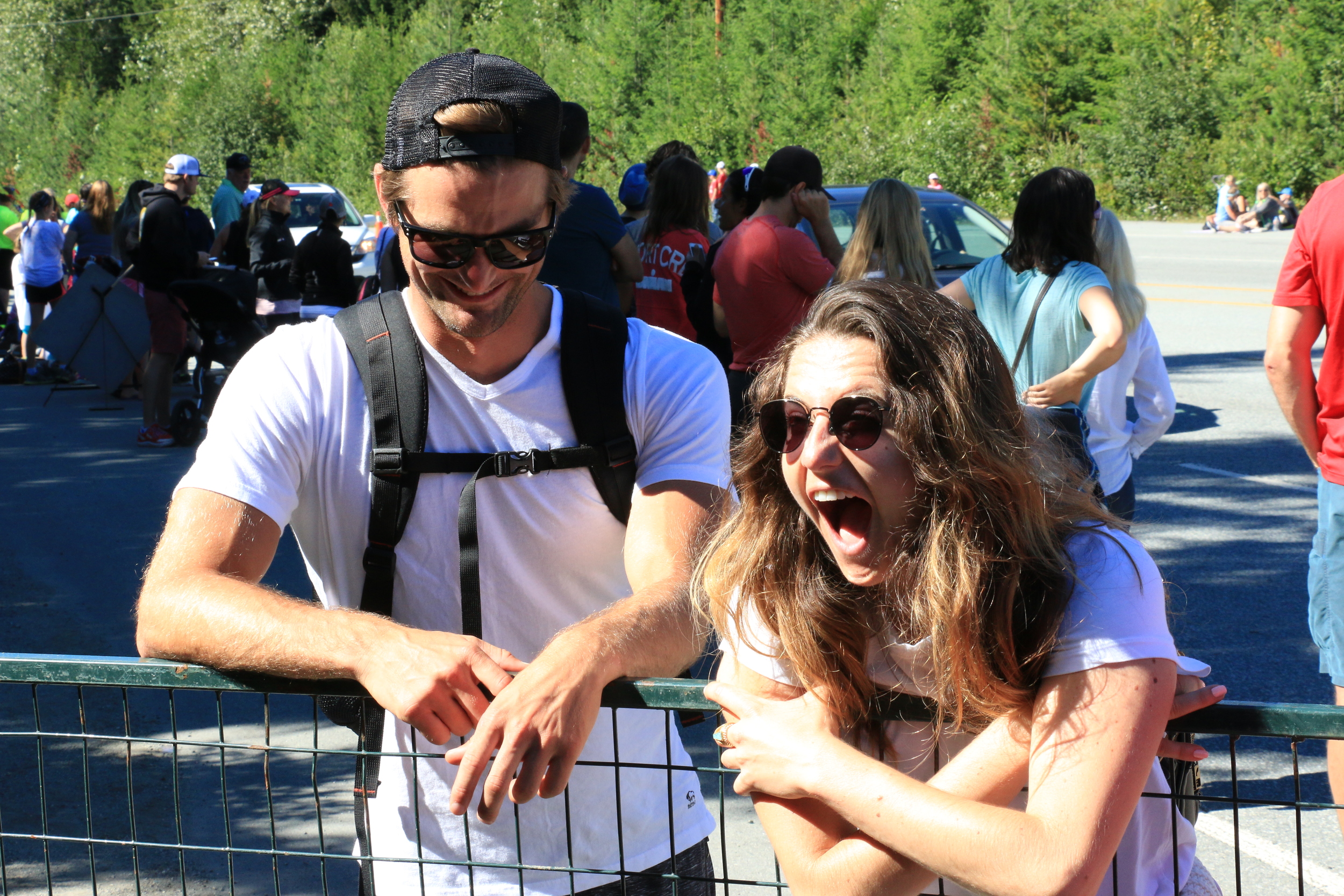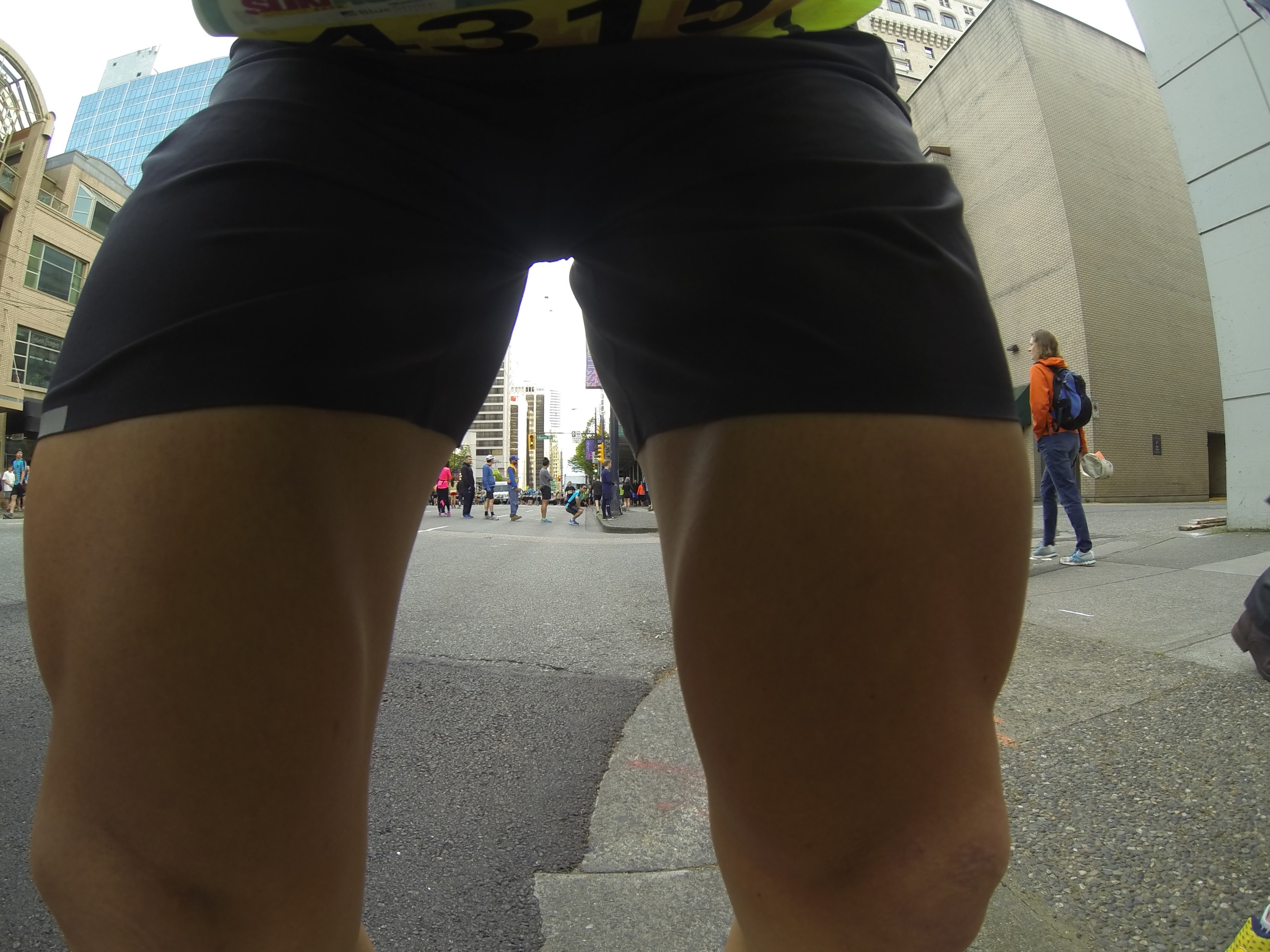Tuc-El-Nuit Lake: what a place to race!
TL;DR
The Oliver Half-Ironman went down on Sunday June 5th, 2022. The course included a 2.0km swim, 89km bike and a 21km run.
Overall, it was a pretty good day out! Rather hilly, very wet bike. Run was solid. Swim remains my biggest area to improve: I’m giving up 10-20 mins of time there. Transitions were slow (6 mins each vs. the usual 1-3 mins) as my hands were cold and not working, and everything was soaking wet from the rain. And I needed to pee like a racehorse in T2. I gave myself the small comfort of fresh, dry socks for the run and that turned out to be a great move. Pumped with how I played the day as it came; kept a strong mental game (even in the water); fuelling + nutrition strategy were on point; good gear choices (road bike with mini aero bars was 👌🏼). Overall a well executed day. I’d say we’re in a good place going into the final three months leading up to Ironman Canada in Penticton.
Goals
The overall theme was about learning versus ‘crushing it’. Of course I wanted to do my best time on the day, but it’s easy to get lost in fighting the clock and then forget about everything else in the process. So here’s what I wanted to focus on.
Can I get through a half-Ironman distance event healthily? It’s been six years since my last half-Ironman and I’ve been working through some persistent right knee issues (again). In January, I was ready to throw the towel in because I couldn’t get on the bike or go for a run without the knee really becoming painful over the course of an effort. Instead, I doubled down and got to work with more and different recovery protocols, and sought out the help of some new body workers (physio, chiro, and RMT). I’ve since been able to ramp up my volume, layer on intensity, and the body’s been able to absorb it well. So largely, this race was about overcoming my fear that something was gonna flare up and I was going to have to hobble my way home or worse, DNF.
Pacing. When you race it’s hard to fight that GOOO! impulse. I often feel like my natural default setting here is that if my heart’s not pounding out of my chest I’m not going hard enough. But the thing with Ironman is that you’re not operating at threshold for 12 hours. Not even close. You’re pretty much Zone 2ing the whole thing, and getting used to that is a thing I wanted to work on in this race.
Is an all liquid fuelling strategy still best for me? Six years ago I used 1st Endurance’s EFS to power me to my best 70.3 result to date. It has the highest electrolyte levels of anything on the market, which works for me because I lose a high amount of salt through sweat. They’ve since made some updates to the product’s chemistry and at some point, you need to test whether it really works for you. And while you can use it in training, it’s never quite the same as a race day trial. No-one wants to crap their pants in their A race!
Does my race kit work? I came to Oliver with some gear that’s tried and true, and some newer stuff that I’d only used a few times but not raced with (e.g. sleeved tri suit, race hat). Again, you can train using your gear but there’s always something unique about a race day test.
Mantras
Forecast for race morning: Rain. Lotsa rain.
Typically when I go into these things I set mantras for each of the swim, bike and run as a thing to repeat in my mind when the going gets tough. You want a simple, positive thought to repeat rather than leave empty space in your mind that negative thoughts can creep into. Mantras usually come to me at some point in the weeks prior to an event, but not this time: my primary goal was simply to test my body at half-Iron distance, and see how it held up.
But then, one of my besties, Dave Mackey, sent me this at 4:51am on race morning:
“Revel in the challenge. When the going gets tough just remember who you are and why you’re out there. For the love of sport. For the challenge. Because you can”.
This really resonated because it was the distillation of a few key things.
“Because you can”. It’s a gift to be able to choose your suffering. Lots of people don’t get that choice: suffering is thrust upon them. Or for any number of reasons, they couldn’t make the choice even if they wanted to (e.g. in the case of physical or mental disability). I get to choose to put myself in these situations of discomfort so that I can find ways to learn and grow as a human. I am so grateful for that opportunity and am determined not to waste it. Every start line represents opportunity (in racing, and in life).
“Remember who you are and why you’re out there”. What’s interesting about endurance sports is that we sign up for these things because we want to challenge ourselves. We actively go looking for the discomfort so that we can have a chance to see that we’re made of tougher stuff, capable of doing things we didn’t think we could. We want to see if we can endure. And then all too often you get into it and when things begin to really hurt you start wishing it to be over. It’s normal – almost reflexive – to pull back from discomfort. You start disengaging; searching for physical or mental escapes to the discomfort you’re in and the distance yet to cover. But that’d be missing the point.
What I’m seeking in these experiences isn’t the kudos from having finished the event but the reckoning with self that only this kind of endurance event can dish out. I came looking for discomfort as an opportunity to learn how to experience myself differently when I encounter discomfort in life.
There’s a moment when you feel discomfort and it’s a classic stimulus→response situation. The beauty of endurance sports is that you get served up those moments second after second, for hours upon hours. And it’s just you vs. yourself out there. What I’m looking for is the opportunity to catch myself at the stimulus – “this hurts” – and to learn to linger there for a while, long enough to create some space so that I can think about, and then choose, my response, rather than reflexively pulling the proverbial rip cord. In that space, I want to make friends with the pain, and appreciate it as a necessary step on the path to getting stronger. Then I want to respond with a positive choice: keep going; “good job”. And then do that over, and over, and over again until the finish line.
That’s why I’m out there.
“Revel in the challenge.” This became the mantra of the day; the four words that tied together all the above into one anchoring statement. When I got to the end of the first lap in the swim I thought: “Enjoy this – it’s going to be a few months before you get to do this again. Don’t wish it away”. Same on the bike. When I got to the turnaround: “You’ll be in T2 before you know it. So enjoy this. It’s your favourite”. And on the run: “Revel in this challenge. You’ve worked all day to get to this point: when you’d like it to be over. This is your chance to be in it and choose different. Don’t miss the whole point of today. Make friends with the discomfort. Choose to continue in the discomfort. Revel in the challenge.”
The race
The Swim: This remains my area of biggest opportunity. Yes, the swim is a small portion of the overall event – but I’m just losing so. much. time. in the swim. The gap between me and the fastest swimmers in Oliver was 18 minutes! All aspects of my swim need work: fitness, form, tactics and open water navigation. What went really well this time around was the head game: no major anxiety aside from a few nerves; I stayed positive the whole time and came out of the water in a good head space. Having that positive mantra really helped keep the brain train on the right track.
The Bike: My favourite. It’s always a big confidence boost, because – having come out of the water relatively late – I then spend the next 2.5 hours passing people. I realized that I was a bit heavy on the power in the first 10km and eased up knowing that this was a 90km ride, not a 40km ride. I was grateful for all the climbing in the first half of the course because it helped generate body heat while we were being hammered with the rain.
Elevation profile for the bike course: no flat sections; if we weren’t going up, we were coming down!
The Run: Perhaps the best part of the day this time around. Historically the run – for me – has been about just hanging on until the end. Not this time. I’ve been running consistently with Mile2Marathon since January and those twice weekly group workouts have really improved my run fitness. I felt strong throughout the run and found my body naturally gravitating toward ~4:45/km pacing which was awesome. The day was starting to heat up Okanagan-style and I made sure I practised using the aid stations like it was a full Ironman: walk through them, take lots of cold fluids + nutrition if needed, keep going. The knee started feeling a bit tight around the seventh kilometre but it was entirely manageable and not a big issue. That built a lot of confidence.
Final times:
Swim: 43:41
T1: 6:03
Bike: 2:38:59
T2: 6:05
Run: 1:44:42
Total: 5:19:30
Kit + gear choices
Equipment won’t win you the day but it can definitely help. Here’s a roundup.
Bike: Scott Foil with mini-aero bars over my tri bike option. Why? Forecast was for rain; roads were unfamiliar; hilly elevation profile with no flat, you were either going up or coming down. Overall, I went with the roadie and I’m certain that was the better choice, because I had more stability and more confidence rolling at speed through wet conditions. Also, I’ve been having some troubles with my left QL (quadratus lumborum) and being able to get out of the saddle and up onto the hoods during the climbs really helped release the lower back and help keep me comfortable.
Keeping the transition gear in the plastic bag was a big win: my runners stayed dry!
Helmet: POC Omne Air Spin. It’s my regular and works great. Probs gonna get an aero helmet for Ironman.
Cycling shoes: Giro Imperial with double Boa closures. This was a change from normal. Typically I use triathlon shoes and have them pre-mounted to my bike, so that I can do the whole flying mount / dismount thing and reduce my transition times. That said, I’m going to use the Imperials in Ironman, I’ve had all my recent bike fits done with them, and they work really well for me, so I’m choosing them over speedier transition times.
Race suit: It was time to try a sleeved race suit and I also wanted something that looked good that wasn’t entirely black. There are surprisingly few options out there: it’s either plain black, or colour / logo barf. I’d like to race and not look like a complete dork! Wyn Republic is a company out of Australia who are making some pretty nice suits, though they are a bit on the expensive side (pricing in US dollars doesn’t help). I snagged a Memorial Day deal and am stoked with my new suit. It fits perfect, has everything I need in terms of fabrics and function, and the design is super rad! When you feel like a boss you race like a boss and it was also pretty fun getting a bunch of comments on course from the crowd to the tune of ‘hey that kit actually looks good’. Post-race, I had one tiny point of chafing on the front of my left hip but otherwise, top marks for the suit and I’ll be rocking this one at Ironman.
Wetsuit: Orca 3.8. Old faithful. I’ve had this one since I started triathlon back in 2014. It’s always fit pretty tight – but for some silly reason, I’ve never actually really checked. So post race, convinced that my wetsuit is indeed too tight, I went and checked the Orca sizing charts. And if things haven’t changed, my suit is indeed, one size too small. Now, it’s entirely possible their fit blocks have changed over the last eight years. But either way, I’ve definitely got my money’s worth out of this suit, and I really want to be comfortable in that Ironman swim, so I’m gonna start looking for a new one.
Run shoes: On Cloudflow. I love these kicks. I’ve trained and raced in all three generations of them and they keep delivering. They’re light, comfy and damn fine lookin’. I love On Running’s aesthetic. I tried the Cloudboom in training (an even more race oriented shoe with a carbon plate) and they gave me blisters and chafing, so I stuck with the Cloudflow. One thing I just didn’t make time to do was set them up with elastic laces, and that cost me time in T2. My hands were so cold coming off the bike, it took me a loooong time just to tie my laces. Will fix that for Ironman.
Run hat: Got me a Ciele trucker hat (“TRKCap SC“). I have a big melon and most of the Ciele caps don’t work for my head. This is a new (bigger) construction and it rocks because it does. And it wicks. And looks rad.
Sunnies: Oakley Sutro Lite with Prizm Low Light lenses. These were a great choice because the bike was super rainy and the sky was dark and overcast. I love the Sutro lenses on the bike because they give you great coverage – kept the rain and wind out of my eyes.
Hacks that worked really well: Putting all my stuff in transition into a plastic shopping bag so that it wouldn’t get soaked in the rain. Being able to put on dry cycling shoes and dry runners was sublime.
Extras: I took a wind vest, merino arm warmers, and two different options of cycling gloves. Despite the rain, I felt like I’d be warm enough to not need the extra bulk on the bike, so took none of these with me on the ride. Indeed, my hands were cold coming off the bike, but my core body temp was good and ultimately, I’m happy with my choices.
Nutrition + fuelling strategy
Pre-swim: One small bottle of EFS, pre-loading the body with electrolytes and carbs.
On the bike: 2x 770mL bottles with 1st Endurance EFS at 7% carbohydrate concentration: 54g total carbs in each bottle. 1x Huma gel (with caffeine) and a splash of water from a bottle grabbed while rolling through an aid station.
On the run: Huma gels at 4k (with caffeine), ~10k (no caffeine) and 17k (no caffeine). Last one was probably a bit late. Had salt chews with me but didn’t take any – that may have been a mistake in a longer event but I got away with it this time. Only one energetic wobble the whole day and that was at 17k. It was probably a bit late to take down that last gel but I did it anyway, just in case. If nothing other than a placebo effect, it worked and I had power through to the finish line.
The event
Pre-race briefing at Tuc-el-Nuit Elementary School.
This triathlon was put on by Dynamic Race Events who are a Canadian owned company and they did a great job. The organizers are friendly and helpful and the volunteers were fantastic. The only thing that sucked was the race tee – but they’re not alone on that front. So many races just have the most barf-worthy t-shirts; I don’t get it! I’d love an option to not get the shirt (save the resources), or choose something else like a bottle opener or key ring (i.e. something I might actually use).
Overall
It was a well executed day and I’m stoked to be participating in long course triathlon again. Onwards to Ironman Canada!












































































